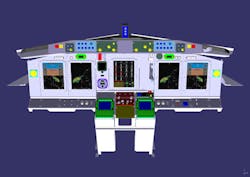Air Force and NATO select Boeing to modernize avionics and flight deck for AWACS fleets
SEATTLE, 24 May 2012. The Electronic Systems Center at Hanscom Air Force Base, Mass., has selected Boeing [NYSE: BA] to develop a design that modernizes the flight deck and avionics of the U.S. and NATO E-3 707 Airborne Warning and Control System (AWACS) aircraft fleet. The contract is valued at $368 million.
The contract is the second phase of a cooperative program between the U.S. Air Force and NATO. The initial phase included subsystem requirements reviews that were completed in March.
Under the contract, Boeing will integrate new and existing avionics and communications systems; develop a design to install the new equipment; upgrade one aircraft for each AWACS fleet; flight-test the new systems; develop logistics support data; and train flight crews and maintenance personnel.
The upgraded flight deck will feature five main glass displays, offering the pilot and co-pilot engine, navigation and radar data. The upgrade also will reduce the flight deck crew from four to three personnel.
The AWACS is an airborne radar system designed to detect aircraft at long ranges and control airspace in a battle by directing aircraft. AWACS aircraft are used to provide surveillance, battle management and command and control as well. AWACS aircraft are used in defensive and offensive air operations.
Common AWACS aircraft are the Boeing E-3 Sentry, based off the Boeing 707 mid-sized airliner, and the Northrop Grumman E-2 Hawkeye, a mid-sized twin-turboprop aircraft. Both of these aircraft feature large, rotating domes that contain antennas and radar for AWACS.
Installation is scheduled to begin on the NATO AWACS aircraft at a Boeing facility in Seattle during the third quarter of 2013. Modification of the U.S. AWACS begins in 2014. Both will be completed by the end of 2015. Production contracts for the remaining aircraft in the fleets will be awarded later.
Rockwell Collins is supplying the flight management system suite, including the glass displays, air-data computers and flight-management computers. Other suppliers include Telephonics of New York, Thales of Belgium, EMS of Canada and Raytheon of Maryland.
Under the current Block 40/45 program for the U.S. AWACS fleet, Boeing is providing ship-set hardware, installation support, production qualification testing, training equipment development and logistics support. Block 40-45 upgrades include new computers, displays, battle management tools and an open architecture for software upgrades.
